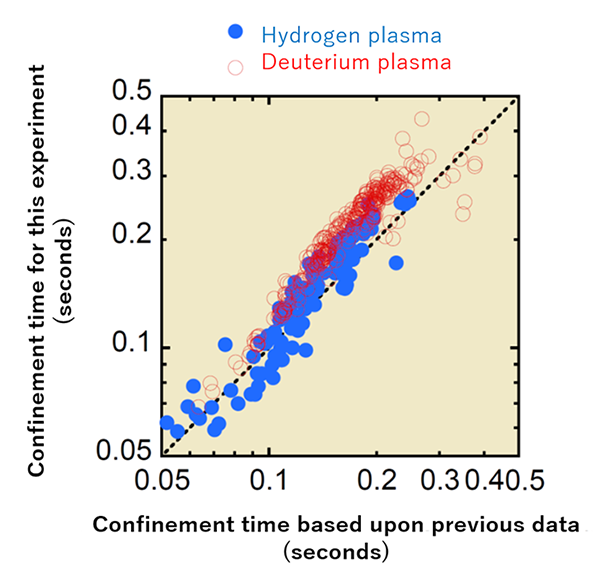HOME > Research Activities > Research Updates >
In order to achieve fusion energy, it is necessary to confine high-temperature plasma in the magnetic field for a long period of time. In the Large Helical Device (LHD), we generate high-temperature and high-performance plasma, and conduct research that investigates the properties of plasma. From March 2017 we initiated plasma experiments using deuterium (deuterium experiments) in order to further improve the high performance of plasma. Among the parameters for indicating plasma performance is energy confinement time (below, as “confinement time”). This parameter indicates the difficulty of energy loss. Considering objects around us we pick up a thermos bottle, as an example. The bottle can contain material at high temperature for longer time, that is, is of higher performance when it is more difficult for heat to escape from inside. We say the state as of good confinement in which energy loss is small and confinement time is long. For plasma, too, confinement performance is considered better, when it becomes more difficult for energy inside the plasma to escape. If we can improve plasma confinement, we can reduce heating power in order to obtain high-temperature plasma and can weaken the magnetic field in order to confine plasma, and can reduce construction costs for the future fusion reactor. Here, we will introduce comparative experimental results regarding how confinement time changed in the deuterium experiment.
First, we will explain deuterium. Typically, hydrogen indicates light hydrogen, which has but one proton in the atomic nucleus. Deuterium has one proton and one neutron in the atomic nucleus, and has the same chemical properties as hydrogen, but the mass is approximately twice as large. Deuterium is found in water as hydrogen is. Hydrogen has natural abundance of 99.985%, and deuterium has 0.015%. Because there is an immense amount of water on Earth, deuterium, as a fuel for fusion energy, provides an inexhaustible supply.
Deuterium experiments were performed on numerous experimental devices before being conducted on the Large Helical Device. Deuterium plasma, compared to hydrogen plasma, has been reported to have better confinement properties compared to hydrogen plasmas. However, in deuterium experiments conducted to date, all have been performed in tokamak devices. The LHD, which is a helical device, uses different coils from tokamak in order to confine plasma. We asked whether using deuterium in the LHD would improve confinement performance. In the 2017 experimental campaign, we investigated how confinement time would differ between hydrogen plasma and deuterium plasma.
The confinement time is measured by heating power and energy stored in a plasma. From numerous plasma experiments conducted to date, confinement time has been related to plasma density and the strength of the magnetic field, and among these we have learned that a relational expression was established. In this way, relational expressions gained from the past quantities of experimental data are called empirical scaling laws. Thus, we predicted confinement time based upon empirical scaling laws that were obtained from experimental data gleaned from earlier helical devices, and we compared the experimental results from hydrogen plasmas and deuterium plasmas in 2017. Regarding various instances in which the plasma density and the heating power differ, the confinement time of hydrogen plasma matched predictions based upon empirical laws. However, regarding the confinement time for deuterium plasma, it became clear that this was approximately 20% longer than that from the empirical law. Based upon this, even in the helical-type LHD, compared to hydrogen plasma, we were able to clearly indicate that confinement performance increased in the deuterium plasma.
When using deuterium, the reasons why confinement performance improves have not yet been clarified. A key for solving this riddle is the “turbulence” generated in the plasma. Turbulence lowers confinement performance. But in deuterium plasma, compared to hydrogen plasma, that turbulence is suppressed has been shown in large-scale simulations performed on a supercomputer. (See back number no. 291.) In the future, together with undertaking detailed comparisons between experiments and simulations, we will clarify the reasons for improved confinement through repeated experiments and seek to link this achievement to further enhancement of confinement performance.
Image
Hydrogen and deuterium plasma confinement times as measured in the Large Helical Device during 2017. The diagonal dotted line in the image expresses predictions based upon scaling laws gained from the past-helical type hydrogen experiments. The hydrogen plasma data (in blue) follows almost exactly the dotted line. Because the deuterium plasma data (in red) is above the dotted line, we learn that confinement performance is improving.
